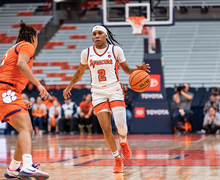5 Years’ Time: Melo Center enhances Syracuse basketball programs on court, in recruiting
Renee Zhou | Asst. Photo Editor
Built in 2009, the Carmelo K. Anthony Basketball Center has enhanced Syracuse's basketball programs on the court and especially in the recruiting fields.
Scoop Jardine was the tour guide. Carl Arrigale, his high school coach, just followed him in amazement.
The new locker rooms, championship trophies — from the national championship, Maui Invitational and much in between — and the shiny, freshly waxed courts. When Jardine first came to Syracuse in 2007, the main practice facility was one Manley Field House court.
Two years later, Jardine had the Carmelo K. Anthony Basketball Center to show off.
“He took us around like a proud pop that day,” Arrigale said.
The Melo Center opened in September of 2009. It’s a $19 million practice facility that has offered a recruiting tool for both the men’s and women’s basketball teams. It has a weight room, training room and video room in a centralized spot. For the athletes, it offers a place to work out 24 hours a day.
The product of its amenities can be measured in wins. In the five years prior to the Melo Center opening, the men’s program averaged 24.6 wins per season. In the five years since, it’s jumped to 29.8. On the women’s side, the number has jumped from 14.2 to 23.8 wins per year, with postseason appearances in each season.
And while there are other factors for this, those in the program say the Melo Center has had a tangible effect.
“It’s the best thing that we’ve ever had happen for us,” men’s basketball head coach Jim Boeheim said. “From a wins-losses standpoint, it’s helped us. Before we couldn’t get the gym, the Carrier Dome or even Manley sometimes.
“People thought it would be a recruiting advantage. I think it’s been more of a playing advantage.”
Before the Melo Center was built, the practices were held in Manley when the court was available. Then, when football season ended, the basketball team moved to the Carrier Dome.
If a player wanted to practice, there’d be no guarantee of space. Any player on any team could use the facility, with track and field athletes pole-vaulting and running in the same space.
The Melo Center provided stability.
“When a guy doesn’t have anything to do before the season or after the season and wants to go in and work out, he has 24-hour access,” said Eric Devendorf, a former SU guard that graduated the year the Melo Center opened. “That’s a big selling point for recruits.”
When building the Melo Center, one of the biggest focuses was its color. Syracuse wanted people to walk in and see its history showcased in orange and navy blue.
But it also wanted to boast its history. Behind one glass case sits a stack of trophies from SU’s overwhelming success in the Big East. Another case is reserved for the trophies the teams hope to win in the Atlantic Coast Conference.
“It’s important to win … I think we are creating our own footprint and our own history,” women’s basketball head coach Quentin Hillsman said. “It’s your facility. You can sell what’s yours.”
The facility belongs to SU because of a $3 million donation from Carmelo Anthony in 2007 — four years after he led the Orange to its only national championship. His name, in addition to the facility itself has been a big pull in and of itself. Class of 2015 commit Tyler Lydon said associating with a player of Anthony’s caliber was “mind-blowing.”
On the ceiling of the entrance hall is a trio of banners with Anthony on them — one of him on the Denver Nuggets, another one of him in a Team USA jersey and one of him in a Syracuse jersey in the middle.
“It’s one of the nicest facilities,” Lydon said. “You can tell you’re getting better in that gym.”
The history in the Melo Center is a product of Anthony’s on-court contributions. When the lights in the hallway turn off at night, there are often still players shooting around in the gym. The national championship trophy that separates the gym and hallway glows so everyone in the gym can see it.
It represents the pinnacle of Syracuse’s success and it sits in a place that’s designed to make it all happen again.
“Winning, it’s what you do,” Boeheim said. “And your practice facility is a part of that.”
Published on September 18, 2014 at 12:03 am
Contact Sam: [email protected] | @SamBlum3




